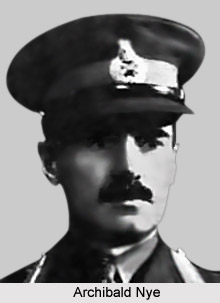 Archibald Nye, formally known as Lieutenant General Sir Archibald Edward Nye, GCSI, GCMG, GCIE, KCB, KBE, MC, served as one of the Governors of Madras Presidency from the year 1946 to 1947, in undivided India under the rule of the British Empire. He was also a British peer and a colonial Army officer who served in the First World War and the Second World War. Nye served as Vice Chief of the Imperial General Staff in World War II. Later he was appointed as the Governor of Madras in British India. Archibald Nye also acted as the High Commissioner to Canada.
Archibald Nye, formally known as Lieutenant General Sir Archibald Edward Nye, GCSI, GCMG, GCIE, KCB, KBE, MC, served as one of the Governors of Madras Presidency from the year 1946 to 1947, in undivided India under the rule of the British Empire. He was also a British peer and a colonial Army officer who served in the First World War and the Second World War. Nye served as Vice Chief of the Imperial General Staff in World War II. Later he was appointed as the Governor of Madras in British India. Archibald Nye also acted as the High Commissioner to Canada.
Early Life of Archibald Nye
Archibald Edward Nye was born on 23 April 1895 at Shipstreet Barracks in Dublin to the parents Charles Edward Nye and Mary Sexton. He was the second son of the couple and had 2 brothers and 3 sisters. His father was a regimental sergeant major in the Oxfordshire and Buckinghamshire Light Infantry. Archibald Nye received his education at the Duke of York`s Royal Military School. After the commencement of World War I, he joined the British army.
Army Service of Archibald Nye
Archibald Nye was selected for a commission in the Prince of Wales` Leinster Regiment in 1915. He was honoured with the Military Cross for his service and bravery. In the year 1932, he successfully completed his graduation in Law and qualified as a Barrister at the Inner Temple. Nye commanded the 2nd battalion of his regiment from the year 1937 to 1939. Lieutenant General Sir Archibald Edward Nye, GCSI, GCMG, GCIE, KCB, KBE, MC came to British India in 1939, in order to brigade and commanded the Nowshera Brigade from 1939 to 1940. In December 1941, he was appointed as Vice Chief of the Imperial General Staff and an acting Lieutenant General. His rank of Lieutenant General was made substantive in September 1944.
Archibald Nye as Governor of Madras
Archibald Nye GCSI, GCMG, GCIE, KCB, KBE, MC was appointed as the Governor of Madras on 26 February 1946 and took charge on 5 May 1946. He was preceded by Sir Henry Foley Knight and served as Governor till 7 September 1948. The Madras Presidency, also known as the Presidency of Fort St. George and Madras Province, was an administrative sub division of British dominated India. The territory included most of southern India, such as the modern states of Tamil Nadu, the Coastal Andhra and Rayalaseema regions of Andhra Pradesh, Lakshadweep Islands, the Malabar region of North Kerala, Koraput, Malkangiri, Nabarangapur and Gajapati districts of southern Orissa and the Bellary, Ganjam, Dakshina Kannada, Rayagada and Udupi districts of Karnataka. During his tenure as Governor of Madras, the province became engulfed by peasant uprisings all over. These revolts were assisted and aided by the Communists who founded minor governments along the northern frontiers of the Madras Presidency thus demanding military action. Nye also served as the Colonel-in-chief of the Madras Regiment from the year 1946 to 1949. He inaugurated the Madras offices of the British Council in 1948.
Honours of Archibald Nye
Archibald Nye was knighted with the Knight Grand Commander of the Most Exalted Order of the Star of India (GCSI) in 1947 and Knight Grand Commander of the Most Eminent Order of the Indian Empire (GCIE) in 1946. He was also honoured with the Knight Grand Cross or Dame Grand Cross of the Most Distinguished Order of Saint Michael and Saint George (GCMG), Knight Commander of the Most Honourable Order of the Bath (KCB), Knight Commander or Dame Commander of the Most Excellent Order of the British Empire (KBE or DBE) and Military Cross (MC). He died on 13 November 1967.
Styles of Archibald Nye
* Archibald Edward Nye (1895- 1914)
* Sergeant Archibald Edward Nye (1914- 1915)
* Sergeant (Temporary Second Lieutenant) Archibald Edward Nye (1915- 1916)
* Second Lieutenant (Temporary Lieutenant) Archibald Edward Nye (1916)
* Lieutenant Archibald Edward Nye (1916- 1919)
* Lieutenant Archibald Edward Nye, MC (1919- 1923)
* Captain Archibald Edward Nye, MC (1924- 1930)
* Captain (Bvt. Major) Archibald Edward Nye, MC (1930- 1934)
* Captain (Bvt. Lieutenant-Colonel) Archibald Edward Nye, MC (1934- 1935)
* Major Archibald Edward Nye, MC (1935- 1937)
* Lieutenant Colonel Archibald Edward Nye, MC (1937- 1939)
* Colonel (Temporary Brigadier) Archibald Edward Nye, MC (1939- 1940)
* Colonel (Acting Major General; Temporary Brigadier) Archibald Edward Nye, MC (1940- 1941)
* Major General (Acting Lieutenant General) Archibald Edward Nye, MC (1941- 1942)
* Major General (Acting Lieutenant General) Archibald Edward Nye, CB, MC (1942- 1943)
* Major General (Temporary Lieutenan -General) Archibald Edward Nye, CB, MC (1943- 1944)
* Lieutenant General Sir Archibald Edward Nye, KBE, CB, MC (1944- 1945)
* Lieutenant General Sir Archibald Edward Nye, KBE, CB, MC (1945- 1946)
* Lieutenant General His Excellency Sir Archibald Edward Nye, GCIE, KCB, KBE, MC (1946- 1947)
* Lieutenant General His Excellency Sir Archibald Edward Nye, GCSI, GCIE, KCB, KBE, MC (1947)
* Lieutenant General His Excellency Sir Archibald Edward Nye, GCSI, GCIE, KCB, KBE, MC (1948- 1951)
* Lieutenant General His Excellency Sir Archibald Edward Nye, GCSI, GCMG, GCIE, KCB, KBE, MC (1951- 1956)
* Lieutenant General Sir Archibald Edward Nye, GCSI, GCMG, GCIE, KCB, KBE, MC (1956- 1967)



















